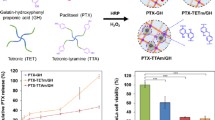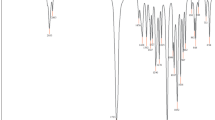Abstract
In this paper, an injectable micellar supramolecular hydrogel composed of α-cyclodextrin (α-CD) and monomethoxy poly(ethylene glycol)-b-poly(ε-caplactone) (MPEG5000-PCL5000) micelles was developed by a simple method for hydrophobic anticancer drug delivery. By mixing α-CD aqueous solution and MPEG5000-PCL5000 micelles, an injectable micellar supramolecular hydrogel could be formed under mild condition due to the inclusion complexation between α-CD and MPEG segment of MPEG5000-PCL5000 micelles. The resultant supramolecular hydrogel was thereafter characterized by X-ray diffraction (XRD) and Scanning electron microscopy (SEM). The effect of α-CD amount on the gelation time, mechanical strength and thixotropic property was studied by a rheometer. Payload of hydrophobic paclitaxel (PTX) to supramolecular hydrogel was achieved by encapsulation of PTX into MPEG5000-PCL5000 micelles prior mixing with α-CD aqueous solution. In vitro release study showed that the release behavior of PTX from hydrogel could be modulated by change the α-CD amount in hydrogel. Furthermore, such supramolecular hydrogel could enhance the biological activity of encapsulated PTX compared to free PTX, as indicated by in vitro cytotoxicity assay. All these results indicated that the developed micellar supramolecular hydrogel might be a promising injectable drug delivery system for anticancer therapy.
Graphical Abstract





Similar content being viewed by others
References
Hoffman AS. Hydrogels for biomedical applications. Adv Drug Deliv Rev. 2012;64:18–23.
Yu L, Ding J. Injectable hydrogels as unique biomedical materials. Chem Soc Rev. 2008;37:1473–81.
Singh NK, Lee DS. In situ gelling pH-and temperature-sensitive biodegradable block copolymer hydrogels for drug delivery. J Control Release. 2014;193:214–27.
Chen G, Jiang M. Cyclodextrin-based inclusion complexation bridging supramolecular chemistry and macromolecular self-assembly. Chem Soc Rev. 2011;40:2254–66.
Qiu Y, Park K. Environment-sensitive hydrogels for drug delivery. Adv Drug Deliv Rev. 2012;64:49–60.
Yan X, Wang F, Zheng B, Huang F. Stimuli-responsive supramolecular polymeric materials. Chem Soc Rev. 2012;41:6042–65.
Ma H, He C, Cheng Y, Li D, Gong Y, Liu J, Tian H, Chen X. PLK1shRNA and doxorubicin co-loaded thermosensitive PLGA-PEG-PLGA hydrogels for osteosarcoma treatment. Biomaterials. 2014;35:8723–34.
Yu L, Zhang Z, Ding J. Influence of LA and GA sequence in the PLGA block on the properties of thermogelling PLGA-PEG-PLGA block copolymers. Biomacromolecules. 2011;12:1290–7.
Ni P, Ding Q, Fan M, Liao J, Qian Z, Luo J, Li X, Luo F, Yang Z, Wei Y. Injectable thermosensitive PEG-PCL-PEG hydrogel/acellular bone matrix composite for bone regeneration in cranial defects. Biomaterials. 2014;35:236–48.
Fu S, Ni P, Wang B, Chu B, Zheng L, Luo F, Luo J, Qian Z. Injectable and thermo-sensitive PEG-PCL-PEG copolymer/collagen/n-HA hydrogel composite for guided bone regeneration. Biomaterials. 2012;33:4801–9.
Lin N, Dufresne A. Supramolecular hydrogels from in situ host-guest inclusion between chemically modified cellulose nanocrystals and cyclodextrin. Biomacromolecules. 2013;14:871–80.
Appel EA, del Barrio J, Loh XJ, Scherman OA. Supramolecular polymeric hydrogels. Chem Soc Rev. 2012;41:6195–214.
Zhang J, Ma PX. Cyclodextrin-based supramolecular systems for drug delivery: recent progress and future perspective. Adv Drug Deliv Rev. 2013;65:1215–33.
Schmidt BVKJ, Hetzer M, Ritter H, Barner-Kowollik C. Complex macromolecular architecture design via cyclodextrin host/guest complexes. Prog Polym Sci. 2014;39:235–49.
Li J, Li X, Ni X, Wang X, Li H, Leong KW. Self-assembled supramolecular hydrogels formed by biodegradable PEO-PHB-PEO triblock copolymers and α-cyclodextrin for controlled drug delivery. Biomaterials. 2006;27:4132–40.
Zhang ZX, Liu KL, Li J. A thermoresponsive hydrogel formed from a star-star supramolecular architecture. Angew Chem Int Ed. 2013;125:6300–4.
Yu J, Ha W, Sun J-N, Shi Y-P. Supramolecular hybrid hydrogel based on host-guest interaction and its application in drug delivery. ACS Appl Mater Inter. 2014;6:19544–51.
Li X, Kong X, Shi S, Wang X, Guo G, Luo F, Zhao X, Wei Y, Qian Z. Physical, mechanical and biological properties of poly (ɛ-caprolactone)-poly (ethylene glycol)-poly (ɛ-caprolactone)(CEC)/chitosan composite film. Carbohyd Polym. 2010;82:904–12.
Li X, Zhang Z, Li J, Sun S, Weng Y, Chen H. Diclofenac/biodegradable polymer micelles for ocular applications. Nanoscale. 2012;4:4667–73.
Zhu W, Li Y, Liu L, Chen Y, Wang C, Xi F. Supramolecular hydrogels from cisplatin-loaded block copolymer nanoparticles and β-cyclodextrins with a stepwise delivery property. Biomacromolecules. 2010;11:3086–92.
Liu KL, Zhu J-l, Li J. Elucidating rheological property enhancements in supramolecular hydrogels of short poly [(R, S)-3-hydroxybutyrate]-based amphiphilic triblock copolymer and ɛ-cyclodextrin for injectable hydrogel applications. Soft Matter. 2010;6:2300–11.
Khodaverdi E, Aboumaashzadeh M, Tekie FSM, Hadizadeh F, Tabassi SAS, Mohajeri SA, Khashyarmanesh Z, Haghighi HM. Sustained drug release using supramolecular hydrogels composed of cyclodextrin inclusion complexes with PCL/PEG multiple block copolymers. Iran Polym J. 2014;23:707–16.
Zhao S-P, Zhang L-M, Ma D. Supramolecular hydrogels induced rapidly by inclusion complexation of poly (ɛ-caprolactone)-poly (ethylene glycol)-poly (ɛ-caprolactone) block copolymers with α-cyclodextrin in aqueous solutions. J Phys Chem B. 2006;110:12225–9.
Acknowledgments
We thanks to the synthesis of MPEG5000-PCL5000 block polymer by Li XY. The authors acknowledge the financial support from Zhejiang Medicines Health Science and Technology Program (2012KYB132).
Author information
Authors and Affiliations
Corresponding author
Electronic supplementary material
Below is the link to the electronic supplementary material.
Supplementary material 1 (MOV 27293 kb)
Rights and permissions
About this article
Cite this article
Fu, C., Lin, X., Wang, J. et al. Injectable micellar supramolecular hydrogel for delivery of hydrophobic anticancer drugs. J Mater Sci: Mater Med 27, 73 (2016). https://doi.org/10.1007/s10856-016-5682-9
Received:
Accepted:
Published:
DOI: https://doi.org/10.1007/s10856-016-5682-9




